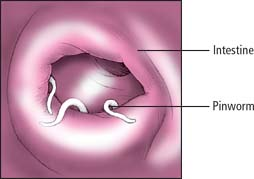Enterobiasis
Enterobiasis (also called pinworm, seatworm, or threadworm infection, or oxyuriasis) is a benign intestinal disease caused by a thin, small, white roundworm that is about the length of a staple. Found worldwide, this disease is common even in temperate regions that have good sanitation. Enterobiasis is the most prevalent helminthic infection in the United States and is especially prominent among school-age children. More than 40 million Americans are estimated to be infected. (See Pinworm infection.)
Causes
Enterobiasis is caused by the nematode Enterobius vermicularis. Adult pinworms live in the intestine; female worms migrate to the perianal region to deposit their ova. Direct transmission occurs when a person’s hands transfer infective eggs from the anus to the mouth. Indirect transmission occurs when an individual comes in contact with contaminated articles, such as linens and clothing. Rarely, a pinworm ova is ingested while breathing; this is possible if the ova is airborne, such as may occur when shaking out linens.
Enterobiasis is caused by a small, thin, white worm that lives in the intestine. It is the most common worm infection in the United States. Although anyone may be infected, it occurs most commonly in children, institutionalized persons, and household members of those who are infected.
 |
Enterobiasis infection and re-infection occur most commonly in children between ages 5 and 14 and in certain institutionalized groups because of poor hygiene and frequent hand-to-mouth activity. Crowded living conditions increase the likelihood of the infection spreading to several members of a family.
Stay updated, free articles. Join our Telegram channel

Full access? Get Clinical Tree


